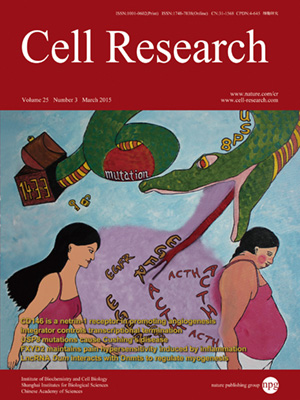
Volume 25, No 3, Mar 2015
ISSN: 1001-0602
EISSN: 1748-7838 2018
impact factor 17.848*
(Clarivate Analytics, 2019)
Volume 25 Issue 3, March 2015: 394-397
LETTERS TO THE EDITOR
A chemical genetic approach to probe the function of PINK1 in regulating mitochondrial dynamics
Conggang Zhang1, Schuyler Lee1, Yinghua Peng1, Eric Bunker1, Chong Shen2, Emilie Giaime3, Jie Shen3, Jingshi Shen2, Zongyao Zhou1 and Xuedong Liu1
1Department of Chemistry and Biochemistry, Jennie Smoly Caruthers Biotechnology Building (JSCBB), University of Colorado-Boulder, Boulder, 3415 Colorado Ave, CO 80303, USA
2Department of MCD-Biology, University of Colorado-Boulder, Boulder, 3415 Colorado Ave, CO 80303, USA
3Center for Neurologic Diseases, Brigham and Women's Hospital, Program in Neuroscience, Harvard Medical School, New Research Building, Rm 636E, 77 Avenue Louis Pasteur, Boston, MA 02115, USA
Correspondence: Xuedong Liu, Tel: 001-303-735-6161; Fax: 001-303-735-6161(Xuedong.Liu@colorado.edu)
PINK1 and Parkin have been implicated in mitochondrial quality control, mitochondrial fusion/fission dynamics and axonal mitochondrial mobility in neurons1,2. The PINK1-Parkin pathway is very dynamic and the biological responses mediated by the PINK1-Parkin pathway differ spatially and kinetically in different cell types2. Therefore, tools to dynamically probe the function of the PINK1-Parkin pathway are highly desirable. Here we report a chemical genetic approach to probe the function of PINK1 in mitophagy and mitochondrial mobility. Our results validate the roles of PINK1 in recruitment of Parkin to mitochondria, mitochondrial mobility in neurons, and mitochondrial fusion/fission dynamics. In addition, we reveal that PINK1 is required for triggering Parkin translocation to mitochondria, but is dispensable for sustaining Parkin accumulation and consequent mitophagy.
10.1038/cr.2014.159
FULL TEXT | PDF
Browse 2194


